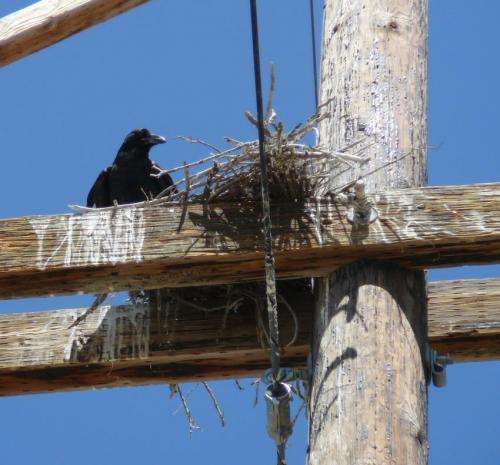Ravens rule Idaho's artificial roosts

A new study by the Wildlife Conservation Society (WCS), U.S. Geological Survey (USGS) and Idaho State University (ISU) explored how habitat alterations, including the addition of energy transmission towers, affect avian predators nesting in sagebrush landscapes.
Researchers compared nesting habitat selection between Common Ravens and three raptor species commonly found in sagebrush ecosystems: Red-tailed Hawks, Swainson's Hawks, and Ferruginous Hawks.
Using the data from their field research and reviewing historical data from other studies, the scientists developed models to predict nesting probabilities for each species. Overall, the analysis showed that transmission towers and other artificial substrates (e.g. cell towers, billboards, buildings) are overwhelmingly preferred by ravens as nesting sites, and are not preferred by any of the three hawk species. A nest located on artificial substrate is nearly 100 percent, 89.4 percent, and 87.1 percent more likely to be that of a raven than that of a Swainson's Hawk, Red-tailed Hawk, and Ferruginous Hawk, respectively.
"Raven populations have increased precipitously in the past four decades in sagebrush ecosystems, largely as a result of fragmentation and development of anthropogenic structures. Our study shows that in addition to habitat fragmentation, the addition of human-made structures benefit ravens, whereas some species of raptors like the Ferruginous Hawk have been impacted and limited in nesting areas," said study lead author Peter Coates, an ecologist with the USGS Western Ecological Research Center.
Why the difference in nest selection between ravens and large hawks? The answer may be linked to the availability of preferred prey. "Ravens are opportunistic foragers, eating just about anything, including carrion. In addition, they tend to be highly intelligent birds that adapt quickly to changing environments and have been shown to transmit learned behaviors from one generation to the next. Conversely, hawks tend to be strongly territorial, intolerant of human disturbance, and prefer prey like jackrabbits that occupy similar habitats," said coauthor and USGS ecologist Kristy Howe, whose masters thesis research with WCS formed the foundation of this study.
The study took place on the sagebrush landscapes of the U.S. Department of Energy's Idaho site and surrounding areas in Idaho, USA, locating nest sites for all four species over a three year span. Researchers analyzed four primary factors that influence nest locations among species:
- presence of artificial nesting substrate versus natural nesting substrate (e.g. trees, cliffs, rock-outcrops)
- presence/absence of agricultural fields,
- amount of native grassland, and
- proximity to habitat edge (where any of four natural habitat types might abut one another) and proximity to human-made features.
Ravens were classified as an uncommon breeder within this area as recently as 1986. Common Ravens are now the most pervasive predatory species nesting in this area, accounting for 46 percent of nests among these four avian predator species.
Transmission towers are the tallest objects at the study area. Nesting on or near them may afford ravens myriad advantages, including a wider range of vision, greater attack speed, and greater security from predators, range fires, and heat stress. While this is good news for ravens, it could be bad news for sensitive prey species, including the Greater Sage-Grouse.
Howe speculates on the study's other implications and directions for future research: "Since ravens are important predators of young birds and eggs, and hawks are predominantly predators of adults, these landscape changes could shift ecosystem dynamics. Predation risk would now likely be greater for sage-grouse eggs and young, and correspondingly lower for adult sage-grouse and other prey species. This adds new insights for ecosystem managers who seek to understand the complex relationships between ravens, hawks, sage-grouse populations, and habitat changes."
"Increases in Common Raven distribution and abundance in the American west mirror declines in distribution and abundance of Greater Sage-Grouse, where energy transmission corridors and other land use changes have altered sagebrush steppe habitat", said David Delehanty of ISU.
"Industrial development, wildfires, invasive plant species, and other disturbances are changing sagebrush landscapes throughout the western United States. Our results shed light on how these avian predators might change with them," said Coates of USGS.
More information: The study, "Landscape alterations influence differential habitat use of nesting Buteos and ravens within sagebrush ecosystem: Implications for transmission line development," will appear in the August 2014 print issue of the journal The Condor.
Provided by Wildlife Conservation Society

















